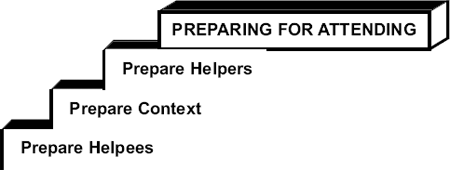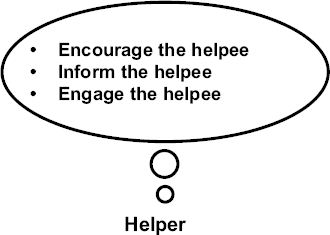The first task in attending is preparing for attending. Preparing for attending involves preparing the helpees, the context and the helpers. If the helpees are not prepared to make the contact, they will not appear. If the context is not prepared to receive the helpees, they will not return. If the helper is not prepared to attend to the helpees, they will not become involved in the helping process. Preparing for attending prepares us for attending personally to the helpees.

PREPARING FOR ATTENDING
The helpees’ willingness to become involved will depend upon how well we prepare them for the helping interaction. Preparing the helpees involves engaging them, informing them of our availability, and encouraging them to use our help.
Engaging the helpees emphasizes greeting them formally and establishing a common frame of reference concerning the purpose of the contact.
Informing the helpees emphasizes communicating: who they will be seeing; what the general purpose of the contact will be; when and where the appointments will take place; and how to get there.
Encouraging the helpees emphasizes providing the helpees with the reasons for becoming involved by answering the following question: “Why do we want to get involved with each other?”

PREPARING THE HELPEE
Our ability to facilitate helpee involvement also depends in part upon preparing the context for the helpee. Preparing the context involves arranging furniture and decorations and organizing our offices or meeting rooms.
Arranging the furniture emphasizes facilitating open communication by positioning the chairs so that the helper and helpee face each other, with no desks, tables or other barriers between them. If there are several helpees, the chairs should be placed in a circle to facilitate the communication of interest and attentiveness to one another.
Arranging decorations emphasizes displaying decorations to which the helpees can relate—reflecting things that are familiar and comfortable to them.
Finally, the helping setting needs to be organized in a neat and orderly fashion. That way we communicate that we are on top of our own affairs and ready to focus upon the problems of the helpees.

PREPARING THE CONTEXT
It is as important to prepare ourselves for helping as it is to prepare our helpees and the context. We prepare ourselves by reviewing what we know about the helpees and the goal of helping as well as by relaxing ourselves.
Reviewing what we know about helping emphasizes reminding ourselves of what we know about the helpees from all previous interactions. This information may include formal notes, intake data and records, as well as informal impressions.
Reviewing the helping goals emphasizes the purpose of the contacts. For example, during the initial stages of helping, the goals will be to involve the helpees in exploring their experiences of their problems.
Relaxing ourselves emphasizes relaxing our minds and bodies prior to the actual helping interactions. Some helpers relax their minds by thinking of pleasant, soothing experiences. Others relax their bodies by physically relaxing one set of muscles after the other. We must experiment and find the method of relaxing that is most effective for us.

PREPARING OURSELVES FOR HELPING
